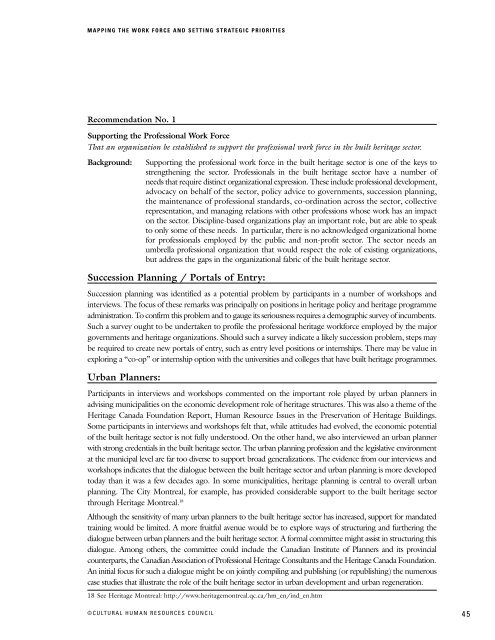Human Resources in Canada's Built Heritage Sector: Mapping the ...
Human Resources in Canada's Built Heritage Sector: Mapping the ...
Human Resources in Canada's Built Heritage Sector: Mapping the ...
- No tags were found...
Create successful ePaper yourself
Turn your PDF publications into a flip-book with our unique Google optimized e-Paper software.
MAPPING THE WORK FORCE AND SETTING STRATEGIC PRIORITIESRecommendation No. 1Support<strong>in</strong>g <strong>the</strong> Professional Work ForceThat an organization be established to support <strong>the</strong> professional work force <strong>in</strong> <strong>the</strong> built heritage sector.Background:Support<strong>in</strong>g <strong>the</strong> professional work force <strong>in</strong> <strong>the</strong> built heritage sector is one of <strong>the</strong> keys tostreng<strong>the</strong>n<strong>in</strong>g <strong>the</strong> sector. Professionals <strong>in</strong> <strong>the</strong> built heritage sector have a number ofneeds that require dist<strong>in</strong>ct organizational expression. These <strong>in</strong>clude professional development,advocacy on behalf of <strong>the</strong> sector, policy advice to governments, succession plann<strong>in</strong>g,<strong>the</strong> ma<strong>in</strong>tenance of professional standards, co-ord<strong>in</strong>ation across <strong>the</strong> sector, collectiverepresentation, and manag<strong>in</strong>g relations with o<strong>the</strong>r professions whose work has an impacton <strong>the</strong> sector. Discipl<strong>in</strong>e-based organizations play an important role, but are able to speakto only some of <strong>the</strong>se needs. In particular, <strong>the</strong>re is no acknowledged organizational homefor professionals employed by <strong>the</strong> public and non-profit sector. The sector needs anumbrella professional organization that would respect <strong>the</strong> role of exist<strong>in</strong>g organizations,but address <strong>the</strong> gaps <strong>in</strong> <strong>the</strong> organizational fabric of <strong>the</strong> built heritage sector.Succession Plann<strong>in</strong>g / Portals of Entry:Succession plann<strong>in</strong>g was identified as a potential problem by participants <strong>in</strong> a number of workshops and<strong>in</strong>terviews. The focus of <strong>the</strong>se remarks was pr<strong>in</strong>cipally on positions <strong>in</strong> heritage policy and heritage programmeadm<strong>in</strong>istration. To confirm this problem and to gauge its seriousness requires a demographic survey of <strong>in</strong>cumbents.Such a survey ought to be undertaken to profile <strong>the</strong> professional heritage workforce employed by <strong>the</strong> majorgovernments and heritage organizations. Should such a survey <strong>in</strong>dicate a likely succession problem, steps maybe required to create new portals of entry, such as entry level positions or <strong>in</strong>ternships. There may be value <strong>in</strong>explor<strong>in</strong>g a “co-op” or <strong>in</strong>ternship option with <strong>the</strong> universities and colleges that have built heritage programmes.Urban Planners:Participants <strong>in</strong> <strong>in</strong>terviews and workshops commented on <strong>the</strong> important role played by urban planners <strong>in</strong>advis<strong>in</strong>g municipalities on <strong>the</strong> economic development role of heritage structures. This was also a <strong>the</strong>me of <strong>the</strong><strong>Heritage</strong> Canada Foundation Report, <strong>Human</strong> Resource Issues <strong>in</strong> <strong>the</strong> Preservation of <strong>Heritage</strong> Build<strong>in</strong>gs.Some participants <strong>in</strong> <strong>in</strong>terviews and workshops felt that, while attitudes had evolved, <strong>the</strong> economic potentialof <strong>the</strong> built heritage sector is not fully understood. On <strong>the</strong> o<strong>the</strong>r hand, we also <strong>in</strong>terviewed an urban plannerwith strong credentials <strong>in</strong> <strong>the</strong> built heritage sector. The urban plann<strong>in</strong>g profession and <strong>the</strong> legislative environmentat <strong>the</strong> municipal level are far too diverse to support broad generalizations. The evidence from our <strong>in</strong>terviews andworkshops <strong>in</strong>dicates that <strong>the</strong> dialogue between <strong>the</strong> built heritage sector and urban plann<strong>in</strong>g is more developedtoday than it was a few decades ago. In some municipalities, heritage plann<strong>in</strong>g is central to overall urbanplann<strong>in</strong>g. The City Montreal, for example, has provided considerable support to <strong>the</strong> built heritage sectorthrough <strong>Heritage</strong> Montreal. 18Although <strong>the</strong> sensitivity of many urban planners to <strong>the</strong> built heritage sector has <strong>in</strong>creased, support for mandatedtra<strong>in</strong><strong>in</strong>g would be limited. A more fruitful avenue would be to explore ways of structur<strong>in</strong>g and fur<strong>the</strong>r<strong>in</strong>g <strong>the</strong>dialogue between urban planners and <strong>the</strong> built heritage sector. A formal committee might assist <strong>in</strong> structur<strong>in</strong>g thisdialogue. Among o<strong>the</strong>rs, <strong>the</strong> committee could <strong>in</strong>clude <strong>the</strong> Canadian Institute of Planners and its prov<strong>in</strong>cialcounterparts, <strong>the</strong> Canadian Association of Professional <strong>Heritage</strong> Consultants and <strong>the</strong> <strong>Heritage</strong> Canada Foundation.An <strong>in</strong>itial focus for such a dialogue might be on jo<strong>in</strong>tly compil<strong>in</strong>g and publish<strong>in</strong>g (or republish<strong>in</strong>g) <strong>the</strong> numerouscase studies that illustrate <strong>the</strong> role of <strong>the</strong> built heritage sector <strong>in</strong> urban development and urban regeneration.18 See <strong>Heritage</strong> Montreal: http://www.heritagemontreal.qc.ca/hm_en/<strong>in</strong>d_en.htm©CULTURAL HUMAN RESOURCES COUNCIL45










